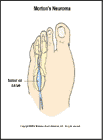
Morton's Neuroma
What is a Morton's neuroma?
A neuroma is a benign (not cancerous) tumor of nerve tissue. A Morton's neuroma most commonly occurs in the nerves between the bones of the third and fourth toes or the second and third toes, but can occur between the bones of any toes.
How does it occur?
A neuroma may be caused by running or walking too much, but often it just occurs on its own. The pain is made worse by running on hard surfaces or by wearing shoes that are too tight.
What are the symptoms?
Your foot is painful. The pain is usually worse when your toes are pointed up. You may get numbness or tingling in the affected area. You have tenderness between the bones of the third and fourth toes or between the bones of the second and third toes.
How is it diagnosed?
Your health care provider will examine your foot and review your symptoms.
How is it treated?
Treatment may include:
- wearing properly fitting shoes
- taking anti-inflammatory drugs
- wearing a pad below one of the bones in your foot or custom-made arch supports (orthotics)
- getting a shot of a cortisonelike medication if the above treatments fail.
Surgery may be required to remove the neuroma.
When can I return to my sport or activity?
The goal of rehabilitation is to return you to your sport or activity as soon as is safely possible. If you return too soon you may worsen your injury, which could lead to permanent damage. Everyone recovers from injury at a different rate. Return to your activity will be determined by how soon your foot recovers, not by how many days or weeks it has been since your injury occurred. In general, the longer you have symptoms before you start treatment, the longer it will take to get better.
You may safely return to your sport or activity when, starting from the top of the list and progressing to the end, each of the following is true:
- You have full range of motion in the injured foot compared to the uninjured foot.
- You have full strength of the injured foot compared to the uninjured foot.
- You can jog straight ahead without pain or limping.
- You can sprint straight ahead without pain or limping.
- You can do 45-degree cuts, first at half-speed, then at full-speed.
- You can do 20-yard figures-of-eight, first at half-speed, then at full-speed.
- You can do 90-degree cuts, first at half-speed, then at full-speed.
- You can do 10-yard figures-of-eight, first at half-speed, then at full-speed.
- You can jump on both feet without pain and you can jump on the injured foot without pain.
How long will the effects last?
The effects of a Morton's neuroma may be temporary or long-lasting. Some people get better simply by wearing more comfortable shoes. Others need cortisone injections or surgery. A cortisone injection may give you relief in a few days to a few weeks. Recovery after surgery takes several weeks or longer.
How can I prevent a Morton's neuroma?
It is not known how to prevent a Morton's neuroma. However, wearing properly fitting shoes with good padding will help decrease the pain of a Morton's neuroma.

